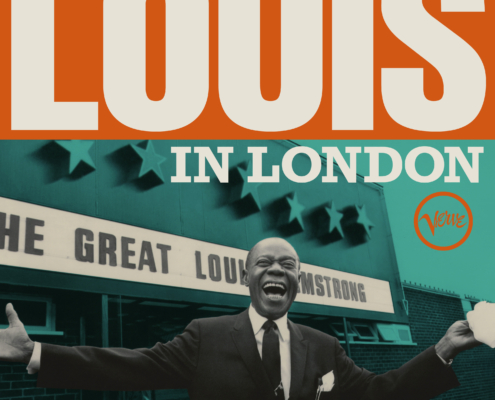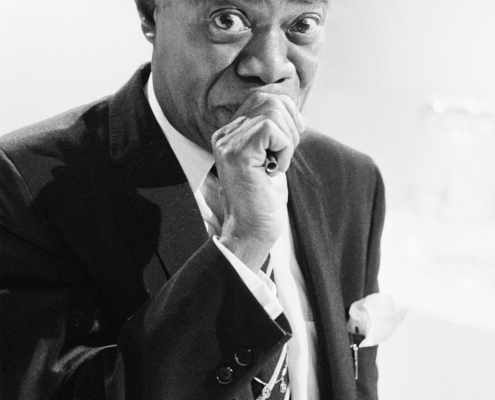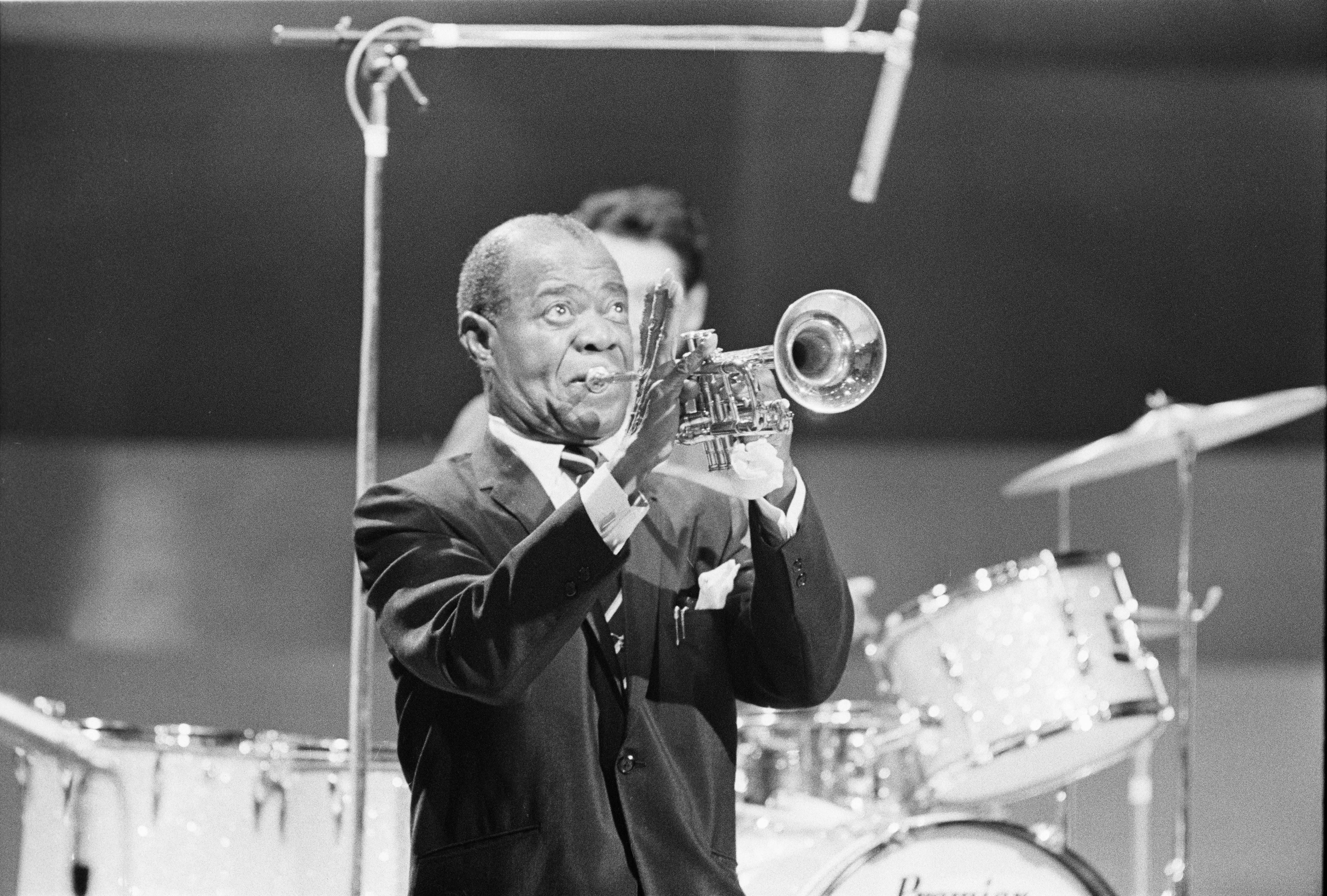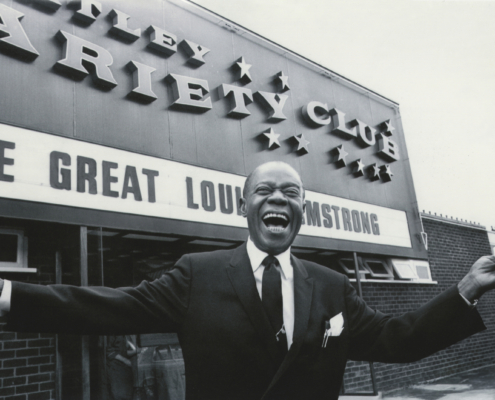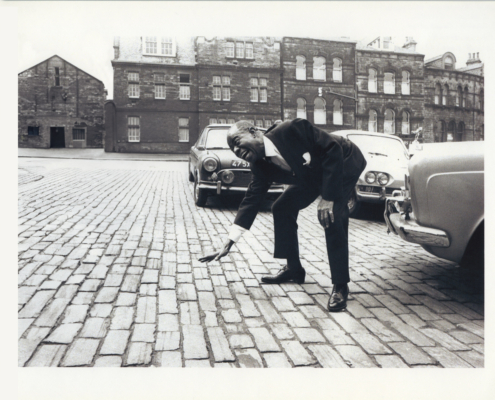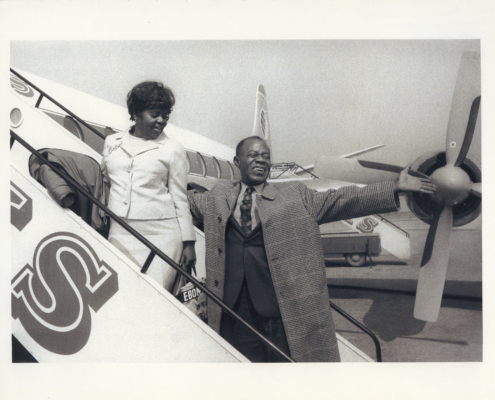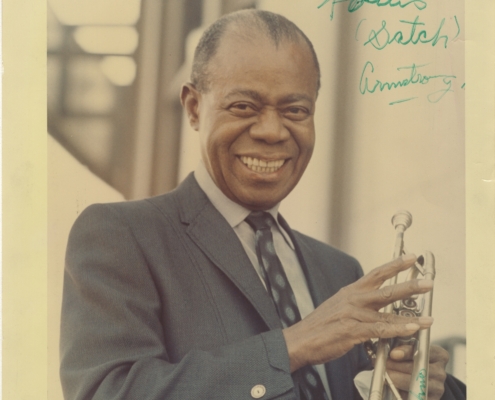Louis Armstrong – Louis In London
TRACKLIST
- When It’s Sleepy Time Down South 3:15
- (Back Home Again In) Indiana 3:42
- A Kiss To Build a Dream On 5:00
- Hello, Dolly! 4:48
- Mame 3:11
- You’ll Never Walk Alone 2:59
- Ole Miss 3:22
- Blueberry Hill 3:35
- Mack The Knife 3:15
- Rockin’ Chair 4:22
- The Bare Necessities 3:20
- What a Wonderful World 2:28
- When The Saints Go Marching In 3:39
Louis Armstrong, trumpet
The All Stars: Tyree Glenn, trombone | Joe Muranyi, clarinet | Marty Napoleon, piano | Buddy Catlett, bass | Danny Barcelona, drums
Recorded in London on July 2, 1968, for “Show Of The Week” (BBC TV)
First broadcast on September 22, 1968
LOUIS ARMSTRONG hat die populäre Musik mehr beeinflusst als jeder andere Künstler davor oder danach. Von der Neudefinition des Jazz mit seinem revolutionären Trompetenspiel bis hin zur Erfindung eines ganz einzigartigen Gesangstils – Armstrong hat überall seine Spuren hinterlassen.
Im Sommer 1968 reiste Louis nach England, nur wenige Wochen nachdem er mit seinem Überraschungshit „What A Wonderful World“ Platz 1 der britischen Charts erobert hatte, und nahm in den Londoner BBC-Studios einen Auftritt voller Vitalität auf, der einige der inspiriertesten Gesangs- und Trompetenmomente seiner gesamten Karriere enthielt.
Leider sollte dieser Auftritt, bei dem er seine gesamte musikalische Karriere Revue passieren ließ, einer seiner letzten bleiben. Der historische Moment, in High Fidelity Audio festgehalten, wird jetzt das erste Mal komplett und sorgfältig remastert veröffentlicht. LOUIS IN LONDON zeigt Armstrong in all seinen Facetten, vom ersten Song den er jemals öffentlich gespielt hat – W.C. Handys „Ole Miss“ – über seinen Chart-Hit „What A Wonderful World“, Jazz Standards wie „(Back Home Again In) Indiana“ und „Rockin’ Chair“, seine ikonischen Versionen von Welthits wie „Mack The Knife“ und „Hello, Dolly!“, bis hin zu für ihn ungewöhnliche Titel wie die heutige Fußball-Hymne „You’ll Never Walk Alone“ und Disneys Dschungelbuch-Klassiker „The Bare Necessities“ (in Deutschland bekannt als „Probier’s mal mit Gemütlichkeit“).
Von dem Moment an, in dem Armstrong selbst eine Kopie der Londoner Aufnahme in den Händen hielt, war er fest entschlossen, die Welt diese Musik hören zu lassen. Er markierte den Tonbandkarton mit dem Vermerk ‘FOR THE FANS’, fertigte Kopien für seine Freunde an und spielte Besuchern bei jeder sich bietenden Möglichkeit das Band vor. Er hätte dafür jede seiner berühmten Aufnahmen aus mehreren Jahrzehnten wählen können, kehrte aber immer wieder zu der BBC-Session aus dem Sommer 1968 zurück.
Fünf Jahrzehnte nach seinem Tod und im Wissen, wie sehr „Satchmo“ wollte, dass diese Musik gehört wird, ist VERVE RECORDS nun stolz darauf, LOUIS IN LONDON als LP, CD und in digitaler Form weltweit zugänglich zu machen, begleitet von ausführlichen Linernotes von Ricky Riccardi, Armstrong-Biograf und Direktor der historischen Sammlung des Louis Armstrong House Museum.
ALBUM LINERNOTES
“For The Fans”
By Ricky Riccardi
On May 16, 1969, Louis Armstrong invited Louis Panassié, son of famed French jazz historian Hugues Panassié, and his wife Claudine over to his home in Corona, Queens. Armstrong was still recuperating from the effects of two extended stays in intensive care but had something new and exciting to show off to his visitors: a set of Tandberg reel-to-reel tape decks his wife Lucille had installed in his den while he was in the hospital. Early in the evening, Armstrong flipped on one of the machines and began recording his conversation with his guests.
Louis sounded quiet and distant at first—he later cataloged this tape as “Satchmo Under the Weather”—but eventually he pulled a tape off his shelves and excitedly described it.
“Here’s a concert, a couple of concerts we did in London–I’ll play some of it anyway–of the last All Stars band,” he began.
“This was done in July of last year,” Lucille interjected.
Louis listed the personnel of the All Stars, stood up, and started loading the tape onto his machine, first playing it at the wrong speed. After futzing around with the new technology, the soothing sounds of “When It’s Sleepy Time Down South” filled the room.
“This is a BBC TV broadcast we made,” Louis explained as his longtime theme song played.
“Indiana” followed, and Armstrong asked Panassié, “Well, Louie, how do you like my gadget there?” His attention immediately went back to the tape. “That’s Marty Napoleon there, on piano,” he said.
Song after song passed and Louis grew quieter and quieter. One could sense that he longed to be back on that stage with that band. He could have chosen a compilation of his Hot Five recordings of the 1920s to show off for his visitors, or perhaps one of his seminal 1950s LPs with the likes of Ella Fitzgerald. But instead, his Tandbergs transported him back to the stage in London the previous summer, when he was feeling well, playing excellently, and singing beautifully. It was uncertain if he’d ever make it back to that point again, so on that May 1969 night with the Panassiés, he found himself living vicariously through the magic of tape, lost in that concert recording from London.
It was a much different situation the previous year. Armstrong opened 1968 with a flurry of activity: appearances on The Tonight Show Starring Johnny Carson and Hollywood Palace, recording sessions for Brunswick and Buena Vista, a tour of Mexico, a performance of “The Bare Necessities” at the Academy Awards telecast, the filming of his show stopping number for the film version of Hello, Dolly!, and a hugely successful two-week engagement at the Latin Quarter in New York City. On top of that, he had lost a tremendous amount of weight and seemed to gain strength back in his sturdy chops after a few years of erratic blowing due to the effects of major dental work in 1965. Armstrong would celebrate what he believed was his 68th birthday that summer and was seemingly hotter than ever—especially in England, where his recording of “What a Wonderful World” topped the pop charts.
The success of that particular single seemed improbable at the time. The song was the brainchild of producer Bob Thiele, who looked over a world torn apart by war, assassinations, riots, and racial unrest, and realized humanity needed a message of hope and optimism and Louis Armstrong was the man to deliver such a message. Thiele hired George David Weiss to write the tune and Tommy Goodman to pen an orchestration, then bathed Armstrong’s wistful voice in the sound of strings and a choir when recording it on August 16, 1967.
There was one problem: Thiele didn’t tell his boss, ABC-Paramount President Larry Newton, about his plan. Newton walked into the session and blew his top at Thiele blowing his budget on having Armstrong record such a sentimental song rather than another “Hello, Dolly!” knockoff. Matters got heated at the session before Newton finally allowed it to continue—getting his revenge by barely publicizing the single upon its release. Though it received positive reviews in Billboard and Cash Box, as well as an emotional performance on The Tonight Show, “What a Wonderful World” sank without denting the pop charts in America.
Newton, however, forgot about the rest of the world. In March 1968, “What a Wonderful World” popped up at number 17 on England’s list of best-selling singles. The next week it was number 9, then 5, and by mid-April, it surpassed efforts by Otis Redding, Tom Jones, and The Beatles to become the number one record in Great Britain, remaining on top into June.
Armstrong once again performed his new hit on The Tonight Show Starring Johnny Carson in late April. “I understand that’s the biggest record in England right now,” Carson said upon its conclusion. “Yeah, one of them good ol’ good ones there,” Armstrong responded. “Struck oil there!” Armstrong then announced that he’d be heading to England that summer to perform at the Batley Variety Club in Yorkshire. “It’s a big deal over there now,” Armstrong stressed.
He wasn’t kidding; Batley paid Armstrong a salary of 10,000 pounds per week for his services. Armstrong would also make it to London, performing two shows a day at both the New Victoria on July 3 and the Odeon Hammersmith on July 4, celebrating his 68th birthday at the latter venue. All four shows completely sold out well in advance, according to Melody Maker.
But it was on July 2 that Armstrong and his All Stars were filmed doing two concerts for BBC television, which make up the recordings heard on Louis in London. The two sets serve as a beautiful punctuation mark on a career that more or less started when Armstrong was incarcerated at the Colored Waif’s Home for Boys in New Orleans 55 years earlier.
Armstrong naturally opens with “When It’s Sleepy Time Down South,” his theme song since the early 1930s and a song he often insisted was his very favorite out of the thousands he recorded and performed in live settings. By this point in his career, any casual Armstrong fan knew that the closing “Good evening, everybody,” would soon be followed by the excitement of “Indiana” and such is the case in London. Armstrong loved to warm up on this instrumental warhorse, sounding particularly virile here. He had made some concessions to age—eliminating his solo for instance—but added a few new touches, such as a quote of “Sidewalks of New York,” before still reaching for the skies at the song’s conclusion.
Clarinetist Joe Muranyi once told me that he could tell that Armstrong’s chops were “percolating” when he called “A Kiss to Build a Dream On,” with its demanding trumpet solo in the middle. Indeed, Armstrong is in control from start to finish here, singing from the heart and filling the room with his still gigantic, warm tone, even as he slowly marches away from the microphone during his solo.
Naturally, no late 1960s show would be complete with “Hello, Dolly!” and this show is no exception, though this is a particularly special version with a forceful trumpet solo—dig the quotes of “Japanese Sandman” and “Stormy Weather”—and two soul-affirming encores. Armstrong had probably performed this song over a thousand times since dethroning The Beatles with it in 1964, but he still manages to approach it with great enthusiasm and vigor, making it sound quite spontaneous even if it was anything but.
Armstrong appropriately follows “Dolly” with “Mame” from the 1966 Broadway show of the same name. This comes from Armstrong’s Mercury period, where his recordings were overseen by Quincy Jones in the hopes of landing another “Dolly”-sized hit. They never did recapture the magic, but “Mame” still landed on the Billboard charts and gave Armstrong another popular song to add to his ever-expanding repertoire.
Armstrong began performing “You’ll Never Walk Alone” from Carousel in the 1950s as a waltz-time medley with “Tenderly,” a showcase for several minutes of powerhouse, melodic trumpet playing. By the mid-1960s, Armstrong could no longer execute the demands necessitated by “You’ll Never Walk Alone” on the trumpet, but he loved the song so much, he began singing it, to great effect. “Louis Armstrong singing ‘You’ll Never Walk Alone,’ which he dedicated to parents of kids in Vietnam on the Tonight Show, was one of the quietly most affecting moments in all music,” columnist Jack O’Brian wrote in October 1967. “Satch delivered the deep-rich drama of the Rodgers-Hammerstein hymn from Carousel better than anyone we’ve ever heard…. Louis’ mood switched from happy to heartbreak in a manner we’ll bet he never anticipated when he struck out on his own more than 40 years ago in Chicago.” Brunswick recorded Armstrong’s vocal version in October 1967 with the hopes that it could be an anthem to rival the new release of “What a Wonderful World.” Armstrong’s recording didn’t crack the charts but at the time of this writing, it currently has over five million views on YouTube and is ripe for rediscovery. This gorgeous, heartfelt version from London might help it along even further.
The first time 15-year-old Louis sat in with trombonist Kid Ory’s band in New Orleans, Ory remembered he was playing W. C. Handy’s brand new composition “Ole Miss.” Over 50 years later, Armstrong was still playing it, and quite well, too, leading the opening and closing ensembles with gusto. This is a good time to pay tribute to this particular edition of the All Stars, which never got the respect earlier editions with bigger names received. Glenn, Catlett, and Barcelona had been together since 1965, with Napoleon joining in 1966, and Muranyi the last hire in 1967. They had toured the world together and knew how to deliver exactly what Armstrong wanted, but they all also swung gracefully and with truly individualistic voices, making it one of Armstrong’s finest ensembles of his later career.
Armstrong follows that instrumental showpiece with two more hits he couldn’t leave out of any of his shows, a wonderfully mellow “Blueberry Hill” followed by a sassy “Mack the Knife,” the latter featuring some searing trumpet playing at the start, especially a surprising second chorus that finds Armstrong still taking chances at this late stage in the game.
The same can be said of Hoagy Carmichael’s “Rockin’ Chair,” a routine Armstrong debuted with Carmichael himself on record in 1929 and performed regularly over the years with several different “fathers,” including Lionel Hampton, Pee Wee Hunt, Jack Teagarden, Trummy Young, and now, Tyree Glenn. Some of the jokes in “Rockin’ Chair” were coined during the Great Depression but, in another sign of true professionalism, Armstrong sells them like it’s the first time he’s ever performed the song. As much fun as the interplay is between Armstrong and Glenn, though, the real goose-bump-inducing moment comes with Armstrong’s brief trumpet statement of the melody up front, where he turns back the clock and recaptures the full sound and power of his playing during those glorious years of the 1940s and 1950s.
Armstrong recorded “The Bare Necessities” from Disney’s The Jungle Book in February 1968 and even performed it at that year’s Academy Awards, where the song was nominated for an Oscar. Armstrong’s success with it led to the eventual recording of a full-length LP of Disney songs, one of his finest late-career albums and, according to his introduction here, an especially popular choice on college campuses. One listen to this infectious live performance explains why that was; Armstrong and Disney truly were a perfect combination.
We then finally arrive at “What a Wonderful World,” still a major hit at the time of Armstrong’s London concert. The All Stars provide sensitive backing but it’s Armstrong’s vocal that still has the power to touch even the most stoic person with a heart of stone. While in London, Armstrong gave an interview to the BBC in which he revealed his personal inspiration for singing it with so much love and warmth: it reminded him of all the kids he watched grow up on his block in Corona, Queens, home of the Louis Armstrong House Museum today.
With the audience clapping along and the band swinging like mad, Louis’s London concert ends with a joyous rendition of “When the Saints Go Marching In,” a song he helped transform from a staid spiritual into a jazz classic with his original Decca recording 30 years prior. Each of the All Stars gets their appropriate due and the audience sounds like they went home happy, much like every other audience that ever had the privilege of watching Armstrong in action.
With Armstrong riding so high in London in the summer of 1968, no one could have predicted the sad turn of events that followed soon after. Losing so much weight so quickly affected Armstrong’s kidneys which, in turn, affected his heart. The first time Louis was admitted to Beth Israel Hospital in September 1968, his longtime wife Lucille feared that the end might be near and knew that her husband’s superhuman work ethic was killing him—hence the purchase and installation of those new Tandberg tape decks. She couldn’t have known it—or maybe she did—but making new tapes would give Louis a reason to live and an opportunity to leave something behind for posterity.
“I am just now getting the hang of my new Stereo set,” Louis wrote to drummer Danny Barcelona on January 20, 1969. “Lucille had it installed for me while I was in the Hospital…When I came home from the Hospital and walked into my Dan and saw that fine – beautiful instrument standing there waiting for me, WOW, I flipped—with Joy, of course.”
Armstrong immediately went about making new “mixtapes,” numbering and cataloging each one, which usually consisted of dubs of his albums from the 1950s and 1960s. But when he got to Reel 25, he was stopped in his tracks by a tape that contained the audio of the two televised sets Armstrong and the All Stars performed for the BBC in London. Knocked out by them, he immediately dubbed the concerts again on Reel 26 of his new series—then copied them one more time on Reel 29.
Armstrong was so energized by what he heard, he began making copies of the BBC concerts, sending them to friends such as Jack Bradley and Jeann “Roni” Failows (their copies are at the Louis Armstrong House Museum) as well as the musicians in his All Stars. In the same letter to Barcelona from January 1969, Armstrong wrote, “Be on the lookout for a Tape I’m Sending to you to keep in your files. It’s the recording that we did in London England, July 2nd, 1968, for the BBC Television Centre. The most relax thing we’ve ever done. One + two sides. A concert on each side. S’too much, man.”
Armstrong added, “The Tape that I’m sending on to you, I’m sending one to each All Star, to Tyree Glenn – Marty Napoleon – Buddy Catlett – Joe Muranyi – Jewel Brown, and now yours’s on the way. You see? It takes time because I have to make copies from the (one tape) that the man sent to me from England.”
Armstrong remained optimistic, telling Barcelona, “When you hear this tape, [you’ll] get homesick for your band – US. I know I can hardly wait to get back on the Mound and in the groove again. (Tee Hee)….After all very few bands get the work like we do. No band in the universe that can boast as much. No such thing as our band ever breaking up for good.”
Indeed, Armstrong was right, to an extent. As his health improved, he began warming up on trumpet every night, eventually getting his doctor’s blessing to perform once more with the All Stars in the fall of 1970. Armstrong reunited most of the 1968 band and headed back to Las Vegas for his comeback, winning nightly standing ovations for his efforts. But it was too much, too soon; by early 1971, he was complaining of shortness of breath and his doctor warned him he could die onstage if he continued. But Armstrong had fought for over two years to make it back to this point and he was determined to continue, preferring to die onstage than to live a quiet retirement.
He almost got his wish. He took a two-week engagement at the Waldorf-Astoria in March 1971, performing two shows a night, needing oxygen between shows to survive. He completed the engagement and suffered a major heart attack, spending many weeks in the hospital and needing a tracheotomy to survive. When he made it back home to Corona, he started a new series of reel-to-reel tapes he called “Armstrong’s Personal Recordings,” a series of compilations he made of his own music, spanning 1923 to 1970. He would make about 20 of these tapes before passing away in his sleep on July 6, 1971.
But the very first volume of “Armstrong’s Personal Recordings” contained something special, a brand-new release, the last new Armstrong album released during his lifetime: Louis Armstrong’s Greatest Hits Recorded Live—a compilation of some of the best moments from Armstrong’s 1968 BBC shows.
Ever since he received the copy of the 1968 London shows on tape, Armstrong became determined to let the world hear this music. As already discussed, he sent copies to friends and musicians but that wasn’t enough. He took the master tape and affixed a piece of tape to the outside cardboard box. On it he scrawled, “FOR THE FANS.”
Armstrong’s determination to let his fans hear this music eventually reached Brunswick records, which had issued I Will Wait for You, an LP of recent singles Armstrong recorded for the label, in late 1968. At some point in 1970, Armstrong and his manager Oscar Cohen convinced Brunswick to do something with the London tapes, issuing nine tracks as selected by Armstrong himself, earning him his one and only producer credit. Armstrong promoted the new LP at a taping of the David Frost Show in February 1971; his friend Dan Morgenstern was there and recalled that Armstrong was very proud of being listed as the album’s producer.
It’s often said that Armstrong’s “final” album was the LP Louis “Country and Western” Armstrong, which was recorded in August 1970; it’s true that that was his final studio album of new material. Some years back, a concert recording from the National Press Club in January 1971 was released and marketed as Armstrong’s final recording; it did, indeed, include the last sanctioned release of live music made during Armstrong’s lifetime.
But I prefer to think of Louis Armstrong’s Greatest Hits Recorded Live as Armstrong’s true final album, a work he wanted his fans to hear and one that he was able to promote on national television just before heading to work one last time at the Waldorf. Kicking off his “Armstrong’s Personal Recordings” series in June 1971, this album was one of the first ones he grabbed. I hope it brought him pleasure.
And now, 53 years after his passing, that original Brunswick LP has been expanded and enhanced as Louis in London, adding two instrumental workouts, that affectionate reading of “You’ll Never Walk Alone,” and a different, longer, and better version of “Hello, Dolly!” to the tracklist. Knowing how badly he wanted his friends and fans to hear this music while he was still alive, it’s a great source of pride to know that it will now be enjoyed by new generations, including many fans who weren’t even alive at the time Armstrong passed, but who are still inspired by his music and his joy.
Armstrong once claimed he was here “in the cause of happiness.” All these decades later, albums like Louis in London continue his life’s mission at a time when we still need to be reminded that maybe it still is a wonderful world and maybe we’ll never walk alone after all.
Ricky Riccardi is the Director of Research Collections for the Louis Armstrong House Museum and author of three Armstrong biographies, in addition to having won a GRAMMY for Best Album Notes.
PR Radio
Universal Music Jazz (Deutsche Grammophon GmbH)
Mühlenstr. 25, 10243 Berlin
Verve Records / Universal Music
CD 00602465686128
LP 00602465543698
VÖ: 12.7.2024

